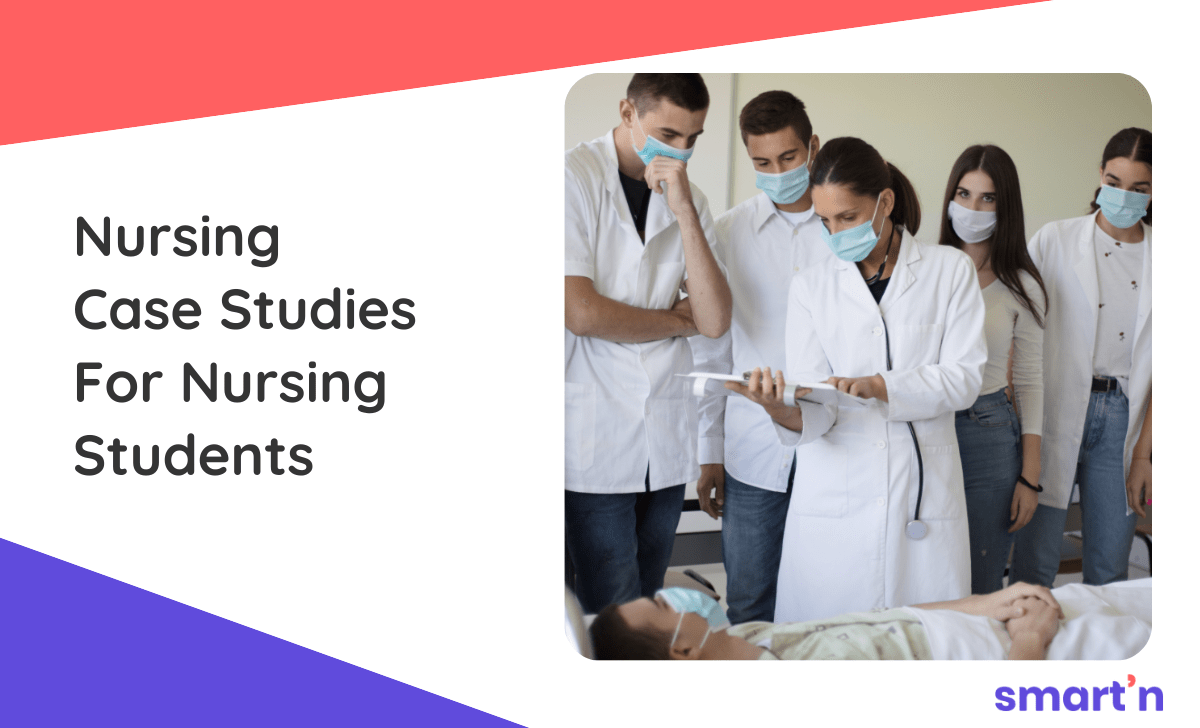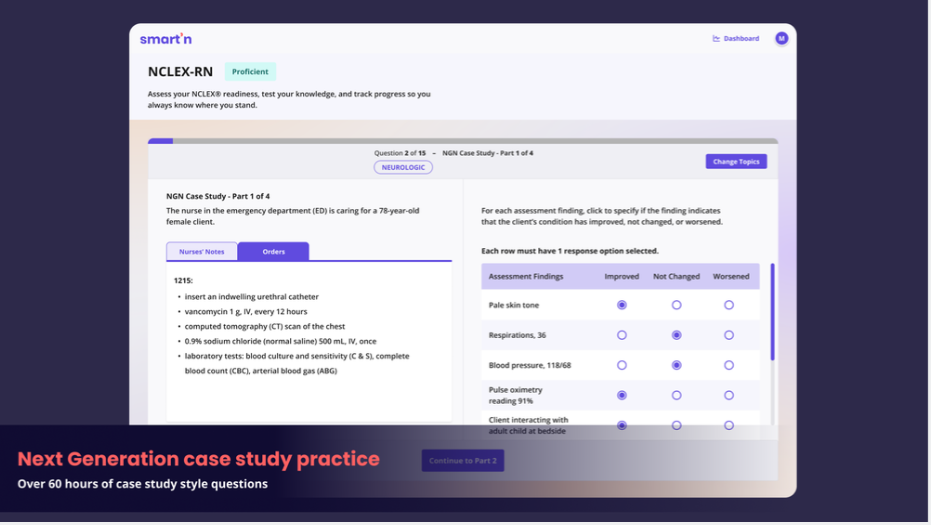60+ Hours Nursing Case Studies For Nursing Students
Nursing education is a complex and demanding field that requires students to develop critical thinking, problem-solving, and decision-making skills.
One effective method to enhance these skills is through the use of case studies. Case studies provide nursing students with real-life scenarios that require them to apply their knowledge and skills to make clinical decisions.
In this article, we will explore the importance of nursing case studies for nursing students, examine real-life nursing case study examples, and introduce Smart’n, where you can find more effective case studies in nursing.
How to approach nursing case studies?
The best way to approach nursing case studies is to use Smart'n. Smart'n is a platform designed to support nursing students in their studies by providing access to a wide range of practice questions, rationales, and assessments.
With over 2,500 NCLEX practice questions and 60+ hours of NGN NCLEX-style nursing case studies available on Smart'n, students can find NextGen questions and case studies that are concise and categorized by topic.
This makes it easier to focus on specific areas of nursing practice, such as respiratory, cardiac, mental health, neurological, and more. To access the NGN case studies on Smart'n, you need to upgrade your free account.
One of the key features of Smart'n is its personalized quizzes. These quizzes are tailored to the individual needs of each student and generated by the platform's AI based on recommended topics for practice. This allows students to focus on areas where they may need more practice or review, helping them to strengthen their knowledge and skills.
Additionally, Smart'n provides ongoing assessments and a clear overview of their performance, allowing students to gauge their progress and identify areas of strength and weakness. This feedback can be invaluable in helping students to target their studies and focus on areas that may require further attention.
Real-life examples of case studies for nursing students
Case studies can cover a wide range of topics in nursing education. And free unfolding case studies for nursing students can be the best choice for those on a tight budget.
Here are three real NGN nursing case studies that we offer at Smart’n:
Case study 1: Integumentary
Let’s check our first unfolding case study for nursing students example:
Case scenario:
Nurse’s notes:
1800: The client was brought to the ED by emergency medical technicians (EMTs) via ambulance after being rescued by firefighters from the kitchen of the client’s burning home. The client was found unresponsive and stabilized on the scene by EMTs. The client arrived with an 18-gauge intravenous (IV) in the left antecubital fossa and oxygen delivery via a non-rebreather mask at 15L/min. The client appears lethargic and short of breath. The client has a hoarse voice when speaking. Vital signs: T 97.8° F (36.5°C), P 114, RR 30, BP 90/56, pulse oximetry reading 91% on 15L/min. The client weighs 85 kg (187 lbs) with a body surface area of 2.01m2. Second and third degree burns located on the anterior chest and abdomen and the top portion of the left arm. Crackles are noted in the bilateral lung bases. Extremity pulses 4+ and regular. The client was unable to hold the right arm up for > 2 seconds, and a cervical spine collar was applied. The physician and respiratory therapy notified regarding the client's condition.
In this case study, the student nurse will identify their first priority action, which assessment finding is a cause for concern, what types of orders the nurse will question, and identify the type of burn the client is experiencing from a real-life picture and plan interventions accordingly.
Case study 2: Musculokeletal
Here is the second sample case study for nursing students:
Case scenario:
Nurse’s notes:
0915: The client arrives at the emergency department (ED), and the writer receives a transfer of accountability (TOA) report from the home care nurse via telephone. Upon assessment, the right big toe has tophi and is erythematous and inflamed. White deposits are noted, and the toe is warm and tender to the touch. No range of motion is present on the right big toe. Pain 6/10 with no movement and 10/10 with a range of motion exercises. Alleviating factors include two 200 mg ibuprofen tablets in the morning and before bed, elevating the foot above heart level, and not moving the toe, walking, or weight bearing. Vital signs: T 100.4° F (38.0°C), P 110, RR 18, BP 140/197, pulse oximetry reading 99% on room air. History of hypertension and kidney stones. Alcohol misuse 40 years ago for approximately 15 years and reports no alcohol consumption since then. Social smoker throughout adulthood. The client states, “It’s just me now, so no need to be social or smoking anymore.” The client was widowed 5 years ago.
In this NGN case study, the nurse will receive new information as they progress through the case. The student nurse will need to anticipate potential orders considering the client's condition, differentiate between gout, rheumatoid arthritis, and osteoarthritis, and analyze laboratory results to guide nursing interventions.
Case study 3: Cardiology
And here is our third nursing critical thinking case study example:
Diagnostic results:
Can you identify the cardiac rhythm from this 12-lead ECG? In one of our cardiology NGN case studies, the student nurse will be responsible for determining which set of actions to prioritize, identifying which abnormal rhythm this client is experiencing, and which type of diagnostics the client should be prepared for based on your nursing assessments.
Importance of case studies in nursing education
Nursing case studies are of great importance for nursing students who are preparing for the Next Generation NCLEX (NGN) exam, as they mimic real-world nursing situations and help students develop clinical judgment and critical decision-making skills.
The NGN NCLEX exam is different from other exams nursing students may have taken in nursing school because it assesses clinical judgment using a measurement model created by the National Council of State Boards of Nursing (NCSBN). This measurement model involves applying various cognitive skills, including recognizing cues, analyzing cues, prioritizing hypotheses, generating solutions, taking action, and evaluating outcomes. Case studies provide students with an opportunity to practice and demonstrate these cognitive skills in a real-world nursing context.
Being proficient in analyzing and responding to case studies will be essential for success in the NGN exam and in preparing nursing students for the challenges they will face in their nursing practice.
Types of nursing case studies
There are different categories and formats of case studies that are commonly encountered in nursing exams. Here are two types of nursing case studies on the NGN exam:
Standalone case studies
In this type of case study nursing, the clinical information about the client is presented at the beginning and remains unchanged throughout the series of questions (six questions).
This means that the details provided about the patient do not change, and the test-taker must rely solely on the initial information to answer all the questions.
Unfolding case studies
In contrast to standalone case studies, unfolding case studies reveal new information as the test-taker progresses through the questions. This means that the scenario or patient information may change or evolve as the questions progress.
The test-taker must adapt to the changing scenario and keep in mind the pertinent details required to answer the questions correctly.
Understanding these different types of nursing case studies can be helpful in preparing for the NGN exam, as it allows the test-taker to become familiar with the formats and adjust their approach accordingly to improve their chances of passing the exam.
Conclusion
Case studies and using patient scenarios for nursing students are among valuable teaching strategies in nursing education that promotes active learning, critical thinking, and clinical reasoning skills. Integrating relevant nursing case studies into nurse students' curriculums can greatly enhance the learning experience and prepare them for the NGN exam and the complexities of nursing practice in diverse healthcare environments.
FAQs
1. Are case studies only applicable to nursing students?
Case studies can be utilized in various healthcare education settings, including nursing, medical, and allied health professions. They can be customized to meet the learning objectives of different healthcare disciplines.
2. How can I create unique and realistic case scenarios for nursing students?
To create unique and realistic case scenarios, consider using real-life patient cases, incorporating diverse patient populations, healthcare settings, and healthcare conditions, and aligning them with the learning objectives of the nursing curriculum.
3. How can I overcome resistance from students who find case studies overwhelming?
To overcome resistance from students who find case studies overwhelming, communicate the benefits of case studies, provide proper support and guidance, and break down complex cases into manageable components. Encourage students to work in groups and seek assistance when needed.
4. How can I assess the effectiveness of case studies in nursing education?
Assess the effectiveness of case studies through formative and summative assessments, such as written assignments, oral presentations, and clinical simulations. Collect feedback from students and incorporate improvements based on their input.





